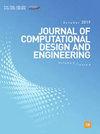Artificial neural network-based sequential approximate optimization of metal sheet architecture and forming process
IF 4.8
2区 工程技术
Q1 COMPUTER SCIENCE, INTERDISCIPLINARY APPLICATIONS
引用次数: 0
Abstract
This paper introduces a sequential approximate optimization method that combines the finite element method (FEM), dynamic differential evolution (DDE), and artificial neural network (ANN) surrogate models. The developed method is applied to address two optimization problems. The first involves metamaterial design optimization for metal sheet architecture with binary design variables. The second pertains to optimizing process parameters in multi-stage metal forming, where the discrete nature arises owing to changing tool geometries across stages. This process is highly nonlinear, accumulating contact, geometric, and material nonlinear effects discretely through forming stages. The efficacy of the proposed optimization method, utilizing ANN surrogate models, is compared with traditionally used polynomial response surface (PRS) surrogate models, primarily based on low-order polynomials. Efficient learning of ANN surrogate models is facilitated through the FEM and Python integration framework. Initial data for surrogate model training is collected via Latin hypercube sampling and FEM simulations. DDE is employed for sequential approximate optimization, optimizing ANN or PRS surrogate models to determine optimal design variables. PRS surrogate models encounter challenges in dealing with nonlinear changes in sequential approximate optimization concerning discrete characteristics such as binary design variables and discrete nonlinear behavior found in multi-stage metal forming processes. Owing to the discrete nature, PRS surrogate models require more data and iterations for optimal design variables. In contrast, ANN surrogate models adeptly predict nonlinear behavior through the activation function's characteristics. In the optimization problem of Metal Sheet Architecture for design target C, the ANN surrogate model required an average of 4.6 times fewer iterations to satisfy stopping criteria compared to the PRS surrogate model. Furthermore, in the optimization of multi-stage deep drawing processes, the ANN surrogate model required an average of 6.1 times fewer iterations to satisfy stopping criteria compared to the PRS surrogate model. As a result, the sequential global optimization method utilizing ANN surrogate models achieves optimal design variables with fewer iterations than PRS surrogate models. Further confirmation of the method's efficiency is provided by comparing Pearson correlation coefficients and locus plots.基于人工神经网络的金属板材结构和成型工艺的顺序近似优化
本文介绍了一种结合有限元法(FEM)、动态微分进化法(DDE)和人工神经网络(ANN)代理模型的顺序近似优化方法。所开发的方法被用于解决两个优化问题。第一个问题涉及具有二进制设计变量的金属板结构的超材料设计优化。第二个问题涉及多阶段金属成型工艺参数的优化,由于各阶段的工具几何形状不断变化,因此产生了离散性。这一过程是高度非线性的,通过成型阶段离散地积累接触、几何和材料非线性效应。利用 ANN 代理模型的拟议优化方法与传统使用的多项式响应面 (PRS) 代理模型(主要基于低阶多项式)的功效进行了比较。通过有限元和 Python 集成框架,促进了 ANN 代理模型的高效学习。通过拉丁超立方采样和有限元模拟收集用于代用模型训练的初始数据。采用 DDE 进行顺序近似优化,优化 ANN 或 PRS 代理模型,以确定最佳设计变量。PRS 代用模型在处理顺序近似优化中的非线性变化时遇到了挑战,这些非线性变化涉及离散特性,如二进制设计变量和多阶段金属成型过程中的离散非线性行为。由于离散性,PRS 代用模型需要更多的数据和迭代来优化设计变量。相比之下,ANN 代理模型能通过激活函数的特性来预测非线性行为。在针对设计目标 C 的金属板材结构优化问题中,与 PRS 代理模型相比,ANN 代理模型为满足停止标准所需的迭代次数平均减少了 4.6 倍。此外,在多阶段拉深工艺的优化中,与 PRS 代理模型相比,ANN 代理模型为满足停止标准所需的迭代次数平均减少了 6.1 倍。因此,与 PRS 代用模型相比,利用 ANN 代用模型的顺序全局优化方法以更少的迭代次数实现了最优设计变量。通过比较皮尔逊相关系数和定位图,进一步证实了该方法的效率。
本文章由计算机程序翻译,如有差异,请以英文原文为准。
求助全文
约1分钟内获得全文
求助全文
来源期刊

Journal of Computational Design and Engineering
Computer Science-Human-Computer Interaction
CiteScore
7.70
自引率
20.40%
发文量
125
期刊介绍:
Journal of Computational Design and Engineering is an international journal that aims to provide academia and industry with a venue for rapid publication of research papers reporting innovative computational methods and applications to achieve a major breakthrough, practical improvements, and bold new research directions within a wide range of design and engineering:
• Theory and its progress in computational advancement for design and engineering
• Development of computational framework to support large scale design and engineering
• Interaction issues among human, designed artifacts, and systems
• Knowledge-intensive technologies for intelligent and sustainable systems
• Emerging technology and convergence of technology fields presented with convincing design examples
• Educational issues for academia, practitioners, and future generation
• Proposal on new research directions as well as survey and retrospectives on mature field.
 求助内容:
求助内容: 应助结果提醒方式:
应助结果提醒方式:


